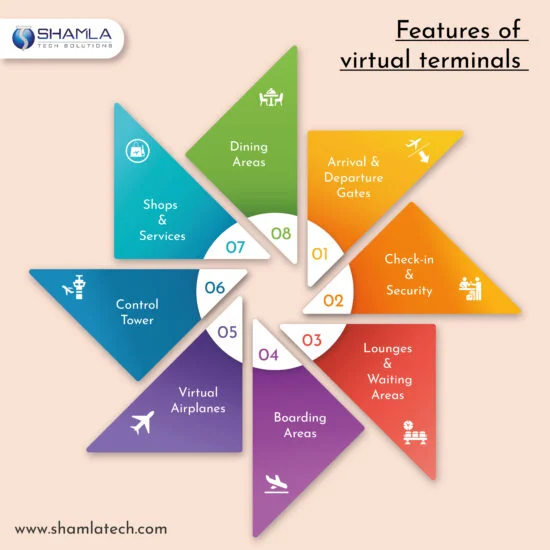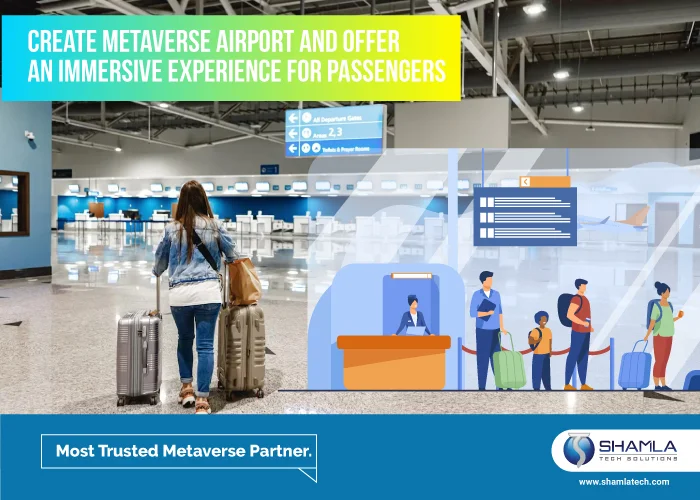The Metaverse is gaining significant popularity in recent times. One of the key factors driving the popularity of the Metaverse is the potential for it to be the next major computing platform. The fame is primarily due to the increasing interest and investment from major technology companies, as well as the growing acceptance and adoption of virtual and augmented reality technologies. The Metaverse is quickly becoming a mainstream topic of discussion in the tech industry. Many experts predict that it will play a major role in the future of computing, entertainment, and social interaction. You can create Metaverse Airport with various advanced features to offer a unique and enticing experience for passengers.
What Is Metaverse Airport?
The Metaverse is a virtual world where users can interact with each other, socialize, and engage in a variety of activities. The term “Metaverse Airport” refers to the idea of an airport within a Metaverse. In this context, an airport would be a virtual location where users can arrive and depart to other parts of the Metaverse or other virtual worlds. The concept of a Metaverse Airport is part of the broader trend of virtual worlds and Metaverse development.
In practical terms, a Metaverse Airport might take the form of a virtual building or location within the Metaverse where users can access different areas of the virtual world, purchase virtual goods, and interact with other users. Create Metaverse airport that serves as a hub for Metaverse-related events and activities, such as virtual conferences or concerts. The Metaverse Airport could potentially provide a range of services, such as virtual check-in, security checks, and virtual lounges.
The concept of a Metaverse Airport is still in its early stages, and it remains to be seen how it will be developed and implemented in practice. However, it is an interesting concept that reflects the growing interest in virtual worlds and the potential for new forms of digital infrastructure.
What Does Virtual Airport Look Like?
A virtual airport in the Metaverse would aim to replicate the experience of a real-world airport as closely as possible, while also incorporating features that are unique to the virtual environment. A virtual airport in the Metaverse would likely include a terminal building with check-in counters, security checkpoints, and gates for boarding planes. The layout and design of the terminal could be based on real-world airports, or it could be a completely unique design created specifically for the Metaverse.
In addition to the terminal building, a virtual airport in the Metaverse could include other features such as runways, taxiways, and control towers. It allows users to experience the full range of activities that take place at an airport. Virtual airports could also include shops and restaurants, as well as areas for passengers to relax and wait for their flights.
One of the key advantages of a virtual airport in the Metaverse is that it could allow users to experience air travel in a more efficient and streamlined way than in the real world. For example, users could check-in for their flights and go through security without having to physically wait in long lines. Additionally, virtual airports could offer a wider range of destinations and flights than real-world airports, since there would be no physical constraints on the number of planes that could take off and land.
Metaverse Airports have limitations only by the imagination of the creators and the capabilities of the technology. We can expect to see increasingly immersive and realistic virtual airports that offer a truly unique and exciting experience for users.
Features Of Metaverse Airport
As the concept of the Metaverse continues to evolve, there may be several possible features of a Metaverse airport. Here are some potential features of metaverse airport:
1. Virtual Terminals
Just like physical airports have terminals, create Metaverse airport that could have virtual terminals which allow users to access different areas within the airport, such as,
- Arrival and Departure Gates
- Check-in and Security
- Lounges and Waiting Areas
- Boarding Areas
- Virtual Airplanes
- Control Tower
- Shops and Services
- Baggage claim areas
- Dining areas
The users can access the virtual terminals through various devices, such as VR headsets or mobile phones.

2. Immersive Experience
One of the key benefits of a Metaverse airport is the potential for a highly immersive experience. Passengers could have the ability to explore the airport in a virtual environment, interact with objects and other users, and even take part in virtual events or experiences as well as play games while waiting for their flights. Create Metaverse airport by using virtual and augmented reality technologies. They can provide engaging and interactive activities that can make the wait for a flight more enjoyable and productive.
3. Customization
Another advantage of the Metaverse is the ability to customize the user experience. Metaverse Airports could leverage AI and other technologies to personalize the travel experience for each passenger. For example, they could recommend customized itineraries, suggest activities or restaurants based on personal preferences, or provide real-time information about flight delays or cancellations. Additionally, a user could choose to navigate the airport in a particular language or customize the virtual environment to suit their preferences.
4. Security And Privacy
Security is always a top concern at physical airports, and the same would be true for a Metaverse airport. Various security measures could be implemented in the virtual environment to ensure the safety of all users. Develop Metaverse Airport that addresses security and privacy concerns by using advanced encryption, authentication, and verification mechanisms. For example, passengers could use biometric authentication or blockchain-based identity solutions to access their virtual terminals and keep their personal data secure.
5. Seamless Integration
While a Metaverse airport is a virtual environment, it could still be integrated with real-world travel. For example, users could access flight information and even check in for their flights from within the Metaverse airport. Metaverse Airports could be seamlessly integrated with other Metaverse platforms and services, such as social networks, e-commerce platforms, or entertainment hubs. Create Metaverse airport that should enable passengers to access a wide range of services and content without leaving the Metaverse.
6. Accessibility
The Metaverse has the potential to create a more accessible airport experience for users with disabilities. Virtual environments could be designed to accommodate different needs and preferences, such as text-to-speech or customizable color schemes. The actual accessibility features offered in a Metaverse airport would depend on the design and implementation of the specific application or platform used to create it. However, the increasing focus on accessibility and inclusive design in the tech industry suggests that such features are likely to be included in virtual Metaverse airports.
7. Socializing
Build Metaverse airport that has the potential to offer various opportunities for socializing and networking. Users could connect with other travelers, attend virtual events, and even join virtual tours of the city or region they are visiting. Socializing in the Metaverse Airport can be a unique and exciting experience, as it provides a virtual space for people from all over the world to connect and interact. By exploring the virtual airport surroundings, striking up conversations, and being open to new experiences, you can make meaningful connections with people.
8. Sustainability
Metaverse Airports could promote sustainability by reducing carbon emissions, resource consumption, and minimizing waste. For example, they could use renewable energy sources to power their servers and devices, or encourage passengers to use virtual transportation options. Metaverse airports can promote eco-friendly behaviors among users by creating virtual events and campaigns that raise awareness about sustainability issues. Sustainability should be a key consideration in the development and operation of Metaverse airports. It can help reduce the environmental impact of virtual worlds and contribute to a more sustainable future.
Finally, a Metaverse Airport could offer a new and exciting way to travel and experience the world.
How Shamla Tech Helps You With The Metaverse Airport?
Shamla Tech is a Metaverse Development company that helps you with the creation and management of a Metaverse Airport. Our experts can design and develop the virtual airport space in the Metaverse. This includes creating a 3D model of the airport, designing the layout, and creating interactive elements such as check-in counters, boarding gates, and shops. We ensure that the user experience in the Metaverse Airport is seamless and intuitive. Our team can create easy-to-use navigation systems, design signage, and wayfinding elements, and ensure that the airport environment is immersive and engaging.
Once the Metaverse Airport is up and running, Shamla Tech can provide ongoing maintenance and updates to ensure that the airport remains current and relevant. This can include adding new features and services, updating the airport layout to reflect real-world changes, and addressing any technical issues that may arise. As a renowned Metaverse Development company, we can help ensure that the Metaverse Airport is a seamless and engaging experience for users, while also integrating cutting-edge technologies such as blockchain to enhance security and functionality.



